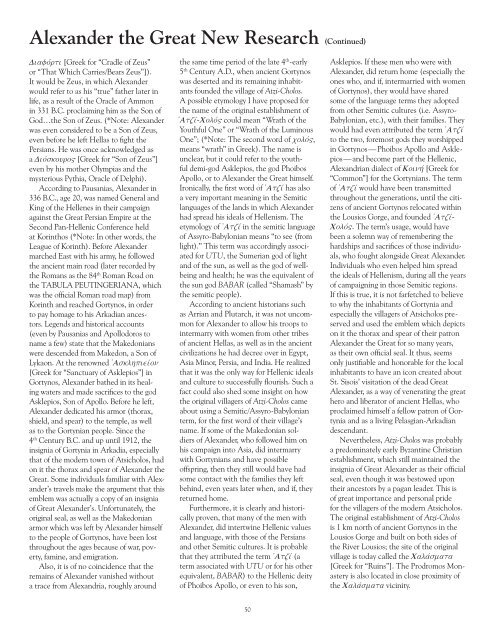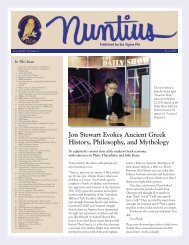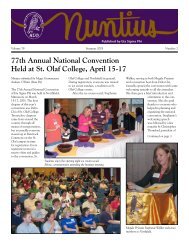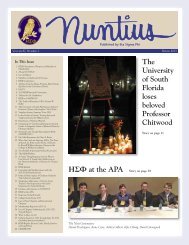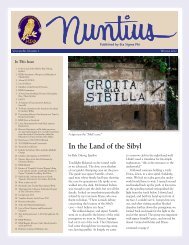Vol. 82, No. 2, Summer 2008 - Monmouth College
Vol. 82, No. 2, Summer 2008 - Monmouth College
Vol. 82, No. 2, Summer 2008 - Monmouth College
Create successful ePaper yourself
Turn your PDF publications into a flip-book with our unique Google optimized e-Paper software.
Alexander the Great New Research (Continued)Diafovrti [Greek for “Cradle of Zeus”or “That Which Carries/Bears Zeus”]).It would be Zeus, in which Alexanderwould refer to as his “true” father later inlife, as a result of the Oracle of Ammonin 331 B.C. proclaiming him as the Son ofGod…the Son of Zeus. (*<strong>No</strong>te: Alexanderwas even considered to be a Son of Zeus,even before he left Hellas to fight thePersians. He was once acknowledged asa Diovskouro~ [Greek for “Son of Zeus”]even by his mother Olympias and themysterious Pythia, Oracle of Delphi).According to Pausanias, Alexander in336 B.C., age 20, was named General andKing of the Hellenes in their campaignagainst the Great Persian Empire at theSecond Pan-Hellenic Conference heldat Korinthos (*<strong>No</strong>te: In other words, theLeague of Korinth). Before Alexandermarched East with his army, he followedthe ancient main road (later recorded bythe Romans as the 84 th Roman Road onthe TABULA PEUTINGERIANA, whichwas the official Roman road map) fromKorinth and reached Gortynos, in orderto pay homage to his Arkadian ancestors.Legends and historical accounts(even by Pausanias and Apollodoros toname a few) state that the Makedonianswere descended from Makedon, a Son ofLykaon. At the renowned jAsklhpieivon[Greek for “Sanctuary of Asklepios”] inGortynos, Alexander bathed in its healingwaters and made sacrifices to the godAsklepios, Son of Apollo. Before he left,Alexander dedicated his armor (thorax,shield, and spear) to the temple, as wellas to the Gortynian people. Since the4 th Century B.C. and up until 1912, theinsignia of Gortynia in Arkadia, especiallythat of the modern town of Atsicholos, hadon it the thorax and spear of Alexander theGreat. Some individuals familiar with Alexander’stravels make the argument that thisemblem was actually a copy of an insigniaof Great Alexander’s. Unfortunately, theoriginal seal, as well as the Makedonianarmor which was left by Alexander himselfto the people of Gortynos, have been lostthroughout the ages because of war, poverty,famine, and emigration.Also, it is of no coincidence that theremains of Alexander vanished withouta trace from Alexandria, roughly aroundthe same time period of the late 4 th -early5 th Century A.D., when ancient Gortynoswas deserted and its remaining inhabitantsfounded the village of Atzi-Cholos.A possible etymology I have proposed forthe name of the original establishment ofjAtziv-Colov~ could mean “Wrath of theYouthful One” or “Wrath of the LuminousOne”; (*<strong>No</strong>te: The second word of colov~,means “wrath” in Greek). The name isunclear, but it could refer to the youthfuldemi-god Asklepios, the god PhoibosApollo, or to Alexander the Great himself.Ironically, the first word of jAtziv has alsoa very important meaning in the Semiticlanguages of the lands in which Alexanderhad spread his ideals of Hellenism. Theetymology of jAtziv in the semitic languageof Assyro-Babylonian means “to see (fromlight).” This term was accordingly associatedfor UTU, the Sumerian god of lightand of the sun, as well as the god of wellbeingand health; he was the equivalent ofthe sun god BABAR (called “Shamash” bythe semitic people).According to ancient historians suchas Arrian and Plutarch, it was not uncommonfor Alexander to allow his troops tointermarry with women from other tribesof ancient Hellas, as well as in the ancientcivilizations he had decree over in Egypt,Asia Minor, Persia, and India. He realizedthat it was the only way for Hellenic idealsand culture to successfully flourish. Such afact could also shed some insight on howthe original villagers of Atzi-Cholos cameabout using a Semitic/Assyro-Babylonianterm, for the first word of their village’sname. If some of the Makedonian soldiersof Alexander, who followed him onhis campaign into Asia, did intermarrywith Gortynians and have possibleoffspring, then they still would have hadsome contact with the families they leftbehind, even years later when, and if, theyreturned home.Furthermore, it is clearly and historicallyproven, that many of the men withAlexander, did intertwine Hellenic valuesand language, with those of the Persiansand other Semitic cultures. It is probablethat they attributed the term jAtziv (aterm associated with UTU or for his otherequivalent, BABAR) to the Hellenic deityof Phoibos Apollo, or even to his son,Asklepios. If these men who were withAlexander, did return home (especially theones who, and if, intermarried with womenof Gortynos), they would have sharedsome of the language terms they adoptedfrom other Semitic cultures (i.e. Assyro-Babylonian, etc.), with their families. Theywould had even attributed the term jAtzivto the two, foremost gods they worshippedin Gortynos — Phoibos Apollo and Asklepios— and become part of the Hellenic,Alexandrian dialect of Koinhv [Greek for“Common”] for the Gortynians. The termof jAtziv would have been transmittedthroughout the generations, until the citizensof ancient Gortynos relocated withinthe Lousios Gorge, and founded jAtziv-Colov~. The term’s usage, would havebeen a solemn way of remembering thehardships and sacrifices of those individuals,who fought alongside Great Alexander.Individuals who even helped him spreadthe ideals of Hellenism, during all the yearsof campaigning in those Semitic regions.If this is true, it is not farfetched to believeto why the inhabitants of Gortynia andespecially the villagers of Atsicholos preservedand used the emblem which depictson it the thorax and spear of their patronAlexander the Great for so many years,as their own official seal. It thus, seemsonly justifiable and honorable for the localinhabitants to have an icon created aboutSt. Sisois’ visitation of the dead GreatAlexander, as a way of venerating the greathero and liberator of ancient Hellas, whoproclaimed himself a fellow patron of Gortyniaand as a living Pelasgian-Arkadiandescendant.Nevertheless, Atzi-Cholos was probablya predominately early Byzantine Christianestablishment, which still maintained theinsignia of Great Alexander as their officialseal, even though it was bestowed upontheir ancestors by a pagan leader. This isof great importance and personal pridefor the villagers of the modern Atsicholos.The original establishment of Atzi-Cholosis 1 km north of ancient Gortynos in theLousios Gorge and built on both sides ofthe River Lousios; the site of the originalvillage is today called the Calavsmata[Greek for “Ruins”]. The Prodromos Monasteryis also located in close proximity ofthe Calavsmata vicinity.50


